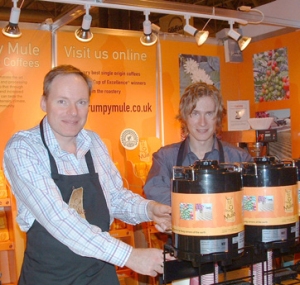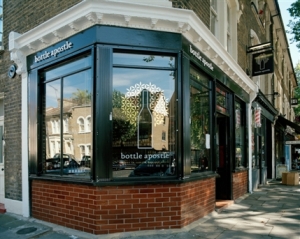On 8 October, I was invited to give a speech at the Technical University Federico Santa María in Valparaíso on “the prospects of (Chilean wine in) international markets from 2010–2015, with a medium to long term perspective and to visualize the position of Chile therein.”
The seminar was called “PVINO VALPARAÍSO” and sought “to integrate related media managed by experts, winemakers, export managers, commerce, hotels, restaurants, tour operators, journalists, Chilean wine companies, and associations attached to the industry.”
My speech is reproduced below. We were permitted 15 minutes, à la Warhol.
A colleague, who very bravely gave the first speech, said that I was “very cool” when I spoke. But he had noticed my leg under the table, jumping around like a fish on the end of a hook…
Perspective of wine on the International Markets 2010–2015
PVINO VALPARAÍSO
Universidad Técnica Federico Santa María
8 October 2009

SDG presenting to PVINO VALPARAÍSO.
Chile has long had connections to the English wine trade. It is praised in The Narrative of the Honourable John Byron, a 1768 account of how he was shipwrecked on the coast of Patagonia and the survivors decided to split into two teams, one to make its way by boat to Rio de Janeiro, the other, Byron’s, to sail north and meet Spanish-speakers.
Nearly 250 years later, the UK is the most valuable wine importing market in the world and until recently was Chile’s number one export outlet. The latest MAT data reveals that, to June 2008, the UK imported 94 million litres of Chilean wine valued at US$229 million. But to June 2009, this had dropped to US$218 million.
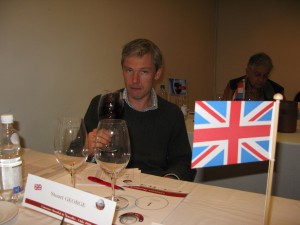
Rule Britannia! SDG tasting at the Concours Mondial de Brussels Chile 2009.
Despite the great challenges of the current UK market to all wine producers, Chile has much to be pleased about. According to the most recent ACNielsen statistics released in June, which cover an extremely difficult period in the UK—indeed, global—economy, Chile’s value is rising faster than its volume. Its average bottle price has increased significantly, from £3.71 in 2003 to £4.13 in 2009, against the current UK average of £4.26. This is Chile’s highest ever-average price, though perhaps one should bear in mind that after taxes have been deducted, it is equivalent to £1.98. Probably the growth would not be so significant if it were not for those annual rises in duty and VAT on wine. But that does mean that the UK consumer is prepared to spend more money on wine when required to do so.
Chile comes in at number seven in the average price chart, just behind Argentina, which averages £4.16.
Currently Chile is in sixth place in its value share of the UK off-trade, behind Australia, USA, France, Italy and South Africa. It is ahead of Spain, Germany, New Zealand and Argentina. It has grown by 15 percent since 2008 to £396 million, growth second only to South Africa, which has grown by 35 percent.
Its volume share of the UK off-trade market is 8.2 percent, also its highest ever. In 2003, Chile’s share was 5.9 percent.
Chile’s share of the off-trade by value is now 7.9 percent. Only six of the top 13 countries by value have shown an increase since June 2008. The top three nations—Australia, USA and France—have all declined. It is perhaps an opportunity for Chile to grab more market share, even if the UK economy remains deeply troubled. Gross domestic product (GDP) fell by 0.6 percent from April to June but there were signs of recovery over the summer and it was expected—or rather, hoped—that there would be growth in the third quarter.
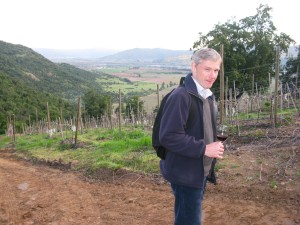
Smug? Moi? SDG at Viñedos Puertas's Cuartel 46 Vineyard, overlooking the El Milagro stud farm.
Chile has done well in the independent off-trade sector over the last three years. It has made strong gains and, again, its value is rising faster than its volume.
Only 20 percent of all Chilean wine sold in the off-trade is at £5 or above but this is growing, up from 15 percent in 2007. This suggests that there might be a bright future for premium Chilean wine at more ambitious price points, particularly the £5–10 category.
To June 2009, Chile sold 41.1 percent white, 51.6 percent red and 7.2 percent rosé. So in the UK, Chile is still primarily considered as a supplier of red wine.
In the UK on-trade, the last two years have seen a significant decline overall, down nine percent by volume and down six percent by value. Australia has declined by 15 percent, South Africa by 16 percent and France by 13 percent. Only Chile, USA and Argentina have shown any on-trade volume growth in this period. Since 2004, Chile has increased its share from 6.5 percent to 9.5 percent, behind USA, Australia, Italy and France.
In terms of the UK market, then, Chile has many things in its favour—good quality, recognised brands such as Concha y Toro, Errázuriz and Viña Maipo; a relative lack of internal politics—think of how this continues to hobble France and Italy; and excellent viticultural resources—a great diversity of microclimates and phylloxera-free soils, much of which can be farmed in an environmentally-friendly manner. The climate change and water issues faced by other countries are far less grave in Chile.
At his lecture given to the WSET in 2003, Eduardo Chadwick referred to “talented young viticulturists and winemakers including Alvaro Espinoza, Marcelo Papa, Adolfo Hurtado, Nicolas Bizzarri and many other names that probably you have never heard of.” Of course, these have all since distinguished themselves. Chile is fortunate to have young, internationally trained winemakers such as these, a vinous version of the “Chicago Boys,” a group of young, well-travelled freethinkers.
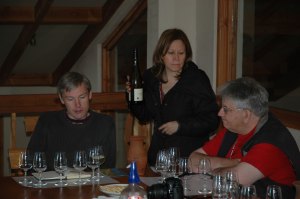
SDG discussing Casa Marin's wines with Christian Callec and Sylvia Cava.
In terms of the wines themselves, I tasted over 60 wines, of different styles and price points, at the annual Wines of Chile tasting in London in early September. I rarely found wines that were over-oaked or had excessive levels of sulphur. Ethyl acetate, or volatile acidity, was sometimes a problem on the least expensive wines—but that would be true of everywhere. Among the newer bottlings, the Pinot Noirs are coming along nicely, I think.
There is undoubtedly great winemaking expertise in Chile. But perhaps Chilean wine needs to decide whether it wants to be big or beautiful. The wines seem to have lost the leafy freshness that made them so appealing a decade ago, with some winemakers nowadays trying too hard to gain power and richness at the expense of elegance and freshness. High alcohol and low acidity is an increasingly unfashionable pairing in the UK market, so Chile must strive to achieve freshness and civilised alcohol levels. The emergence of new, cool climate regions such as the Leyda Valley bodes well for producing wines in this style.
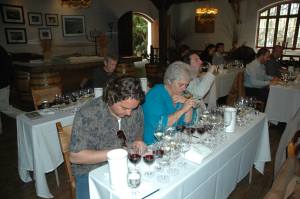
SDG and other tasters assessing Errázuriz wines.
Overall, Chile should continue to improve its already excellent viticultural, winemaking and marketing practices. Chile might also consider more widespread use of screwcap closures, which are well-suited to its commercial, fruit-driven wines. Quality shouldn’t be compromised. Even when times are hard, quality will always sell.
At the commercial level, Chile has done well. The various Concha y Toro brands, for example, represent excellent value for money. Chile certainly has it within itself to produce lots of good, fruity wines. But it has not yet created many fine, or “icon,” wines that would give the country a patina of high achievement and create more profits.
Of course it is quite possible that the best sites in Chile have not yet been planted or even discovered. The possibility of greatness is there—as the vines get older the wines should get better—but it is still too soon for Chile to claim it has world-class wines.
Production of DO wine in Chile has more than quadrupled since 1996. Grape plantings have increased by 120 percent since 1994. But Chile must avoid oversupply, which would ultimately wipe out all the gains made over the last few years. The effects of oversupply and discounting are now being felt painfully by Australia. Marlborough Sauvignon Blanc from New Zealand is now being discounted in UK supermarkets, which could prove fatal for its vaunted average bottle price.
Today Chile has about 6 percent of world exports of wine; Australia has about 9 percent. In the UK, Chile’s share, as mentioned earlier, is just over 8 percent, so slightly above its global share. Australia’s is over 20 percent, which shows how dependent it has become on the UK. Chile should try and spread its exports across as many markets as it can. It should not put all its eggs in the English basket. Chile should not allow itself to be seduced by the UK supermarkets, tempting as their offers might be. There is another 25 percent of the off-trade to be targeted, which includes nearly 700 good independent wine retailers.
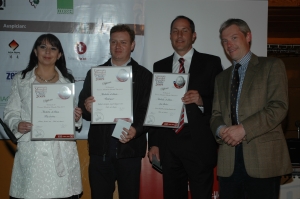
Didn't they do well? SDG with award winners from Valdivieso.
To continue to make progress in the UK market, I think that Chile needs to continue to provide good value for money at all price points, particularly in the £5–10 range; it needs to offer a broad range of varietals and styles— “Day-coloured wine,/night-coloured wine,/wine with purple feet/or wine with topaz blood,” as Pablo Neruda puts it—but without sacrificing Chilean typicité or character. A lot of the wines that I tasted in London recently were perfectly correct but had little to define them as Chilean.
There is a scene in Pablo Larrain’s recent film Tony Manero in which the film’s protagonist Raul, who models himself on John Travolta’s disco king, is told by his girlfriend, “Manero is an American. You’re not. You belong here.” Chilean wine should not try and be Tony Manero. It should be Raul. Perhaps in the UK it needs to promote a stronger national identity to consumers. Australia has kangaroos and cricket. Argentina has football and tango. South Africa has lions and leopards. But for British people there is nothing that immediately comes to mind that is uniquely and recognisably Chilean. There is a lack of cultural links with the UK, no direct flights and little of the tourism that has assisted the wines of Australia, New Zealand and South Africa, but this can be overcome progressively. An identity would help but, on the other hand, negative associations, such as South Africa and Apartheid or Argentina and Maradona, have never hampered Chile.
Without a strong national identity, promoting regionality is some way off yet, I think. The Chilean “brand” needs to be well-established before any attempts at telling consumers the difference between the Elqui Valley and the Malleco Valley. Even Australia is still struggling to push the regional message. It can be done but it will take a long time.
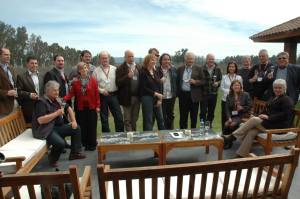
SDG with fellow Concours tasters at Viña Miguel Torres Restaurant.
Gazing into the crystal ball, for the next five or six years I see more of the same in the UK market. There is likely to be ever-increasing taxation on wine and other alcoholic drinks, making price points harder to maintain and squeezing suppliers’ margins. The UK market is often described as “mature,” which is a euphemism for “saturated.” It is and will continue to be a tough place to sell wine.
When the Wines of Chile UK office was reopened in 2002, its vision, as part of a five-year plan, was “to be recognized as the New World’s preferred alternative source of Premium Wine to Australia.” It has not quite achieved this yet, with South Africa ahead of it at the moment. However, I understand that Wines of Chile is currently developing a long-term plan of about 25 years that is due for publication in the first quarter of 2010. I think it is important that there is a plan and everybody is seen to be pulling—or pushing—in the same direction. Think of how the Chicago Boys implemented their long-term economic plans in stages. It need not be another El Ladrillo but Chilean wine needs to have a clear direction.
Michael Cox, the outstanding head of Wines of Chile in the UK, told me, “In my view the future of the Chilean wine business looks extremely positive for many reasons, and the opportunities are substantial. In fact, after nearly 40 years in the wine trade, I have never been more excited about one country’s ability to prosper. I know I am biased (!) but I genuinely feel it.”
So, I would suggest keeping it simple: Make good, fresh wines that are value for money and have something uniquely Chilean about them. There is no need to complicate things like Joseph Conrad does in his Chilean-set novel Nostromo.
I would urge Wines of Chile not to be like the Chilean government was in 1859, when it abandoned all the hard work done by William Wheelwright in establishing a railway over the Andes to join Chile and Argentina. Be like Wheelwright—and keep building that line to Britain!









